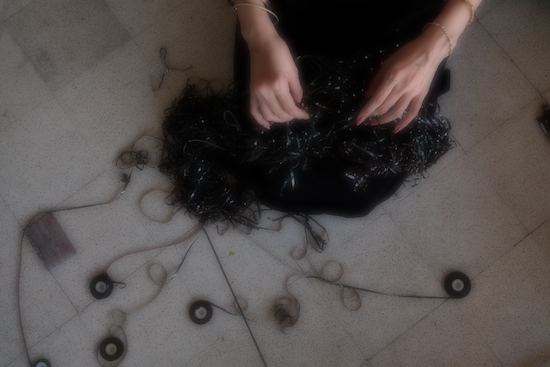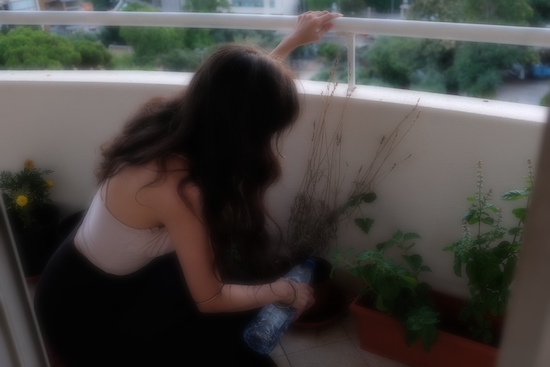As tQ speaks to Beirut-based multi-instrumentalist, video artist and puppeteer Yara Asmar, a universe of soundscapes opens around her. Showing us around her Beirut apartment via Zoom, where she’s set up a small home studio, the sounds of screaming children and ambulance sirens penetrate the room while her two cats bask in the sun. We’re discussing her enchanting second album, Synth Waltzes And Accordion Laments, which charts a deeply personal journey the medium of synths, metallophone, toy piano and music boxes, run through pedals and accompanied by an array of clattering sounds from tin toys to bells. Most important of all, however, is her grandmother’s green Hohner Marchesa accordion
Asmar inherited the instrument by chance. “When I went to The University Of Balamand in 2014 I started studying medicine, and then switched to film and journalism which exposed me to new listening and reading experiences,” she says. “I started listening to pieces by Pauline Oliveros and Yann Tiersen where they used the accordion. We were in the car with my mother, and I told her that I’d love to get my hands on an accordion. She told me that while she was putting away the Christmas [decorations] into the attic, she glimpsed the box which had my grandmother’s old accordion.”
Upon arriving home, Asmar climbed into the attic and there, in a dusty box, she dug out the instrument, which was originally made in Germany. “It was a gift to my grandmother’s brother, but he didn’t play it as much as her so, it became hers,” she says. “My grandmother wouldn’t have called herself an artist, but everything she did was very creative. She was crafty with her hands, as she used to paint on cloth and glass, sow and make other crafts.”
Asmar took the accordion and taught herself to play it. “I used to play the piano when I was little, but I stopped when I turned 14 to focus on my studies. Picking up the accordion, the right hand was like playing the piano, so it was very intuitive. The left hand, however, was slightly intimidating with all the buttons. Slowly, I worked on the instrument and learned that the left hand is arranged in fifths and on the side, it has the chords, which are close to each other so that one can play easily.” Before long, she started performing with it live.
At that time she had only two releases, a commissioned piece called ‘Numbers Don’t Make Good Friends’, from a compilation of young Lebanese artists, and a 20 minute live performance at the Ballroom Blitz venue for the label Ruptured Records that included a synth towards the end. “Ziad Nawfal [Lebanese DJ, radio host and writer] had called me and asked me to record a twenty-minute set. I was nervous at the time; we grew up listening to Ziad on the radio. I spent a week preparing for it, and it was all acoustic.” Then, earlier this year, Asmar was invited to the Black Forest in Germany by the organisation Vogelklang, who host research and production residencies and a festival, Soundcamp, where artists then present the work they make there. “There’s this couple called Olsen [Wolf] and Irene [Pérez Hernández], and they bring artists, scientists and academics to do workshops and sound installations about birds,” Asmar explains. “My grandfather used to record the sounds of birds on reel to reel, and it was all in the attic. I wanted to re-create his work on tapes, as a taped loop sound installation.” This experience would be pivotal in Asmar’s evolution, as she started working on an installation titled The Cut-Throat Finch Preludes. “My grandfather used to raise those birds in cages, and he told me that during the civil war many of them died. Apparently, their eardrums would pop from the gunfire and explosions.”
It was there that Wolf and Pérez Hernández noticed her grandmother’s accordion, which was manufactured in Trossingen, only a ten-minute drive from where Asmar was staying. “We went there to the workshop and when the man working there saw the accordion, he got excited as he recognised it. He rummaged through his shop and took out the ledger, where he found the date when they sent eight accordions to Lebanon; two of them were green and one of those was my grandmother’s. It was shipped on 21 October 1955. My grandmother had passed away, and it was very emotional for me. I wish she was around for her to know what influence her accordion had on my life”. Asmar had already been working on the album for a year; “On my first album Home Recordings”I used glockenspiels, bells, tin toys and it was an exploration of different sound,” she says. However on Synth Waltzes And Accordion Laments she focused more specifically on the accordion, augmenting it with synths and haunting drones.
“My main intention was to focus on depersonalisation and disconnection from our immediate surroundings. I feel that I, and the people around me, need to do that, so that we detach ourselves from the world around us. We need to become a bit delusional to remain sane. I feel like there’s so much theatre, music and film coming from Beirut, but for us to achieve it, we need to disconnect. Us, who remain here, create places that protect us from things that are happening around us.” For Asmar, who also works with puppets, this process can be visual as much as aural. “From a young age I’ve been very anxious, and I isolate myself, so I’m in a little bubble of my toys, instruments, and puppets. I built a little world that protects me and shields me.”
She recorded the album at the forest, and at both her current home and her last one. “We keep moving around as rents rise,” she explains. “The new place has more soundscapes around it.” Along with Marc Teare of Hive Mind Records, she didn’t assemble the disparate collection of tracks in any particular order. “It was a collection, not an album. It’s a slow evolution and documentation of my process. When you incorporate pedals and synths you don’t always get the same results. It takes me outside my comfort zone, and the composition is no longer about the finished piece but about the process of getting there.”
A cascade that embraces a multitude of themes, the tracks are fluid, dreamy and emotive, planted in the here-and-now of their creation. On ‘Everything Is Wrapped In Cling Film’, she bows her disassembled toy piano to create ghostly sounds played in little loops. While she doesn’t use her voice for singing, there are instances where she uses it as an instrument to reproduce sounds from her environment, such as sirens.

‘Three Clementines On The Counter Of A Blue-Tiled Sun-Soaked Kitchen’ is a direct reference to her grandmother’s house. Initially this track was composed for Radio Al-Hara as part of a tribute to pioneering Lebanese organist, composer and arranger Ihsan Al-Munzer. “I took [Al-Munzer’s composition] ‘Sonatina For Maria’ and focused on the main theme by playing it on a synth while slowing it down.” Asmar sharply turned the piece into a nostalgic waltz, and ran it through a modular synth. “I had my grandmother and her kitchen on my mind while working on it,” she says. Its title comes from a poem that Asmar wrote a few years ago about her grandmother, which she also used for another song, “It Is 5:00pm And Nothing Bad Has Happened To Us (Yet)’.
There’s a constant reference to time throughout the record, which seems to seep densely from one note to the next. The music is also laden with memories from the past. “There’s something very touching about an empty chair when you know who’s meant to be sitting there. My grandfather is still alive and he’s unwell. He used to sit at the head of the table and since my grandmother passed away, he doesn’t sit there anymore. Something changed since her passing. She returns to him on ‘From Gardens In The City We Keep Alive’, and his home in the Ashrafieh neighborhood of Beirut. “I grew up in that neighborhood and my grandfather lives on the sixth floor, where he’s planted a lot of plants. The building is surrounded by concrete, yet his balcony is filled with avocados and passion fruit trees”.
‘Jumana’ is named after Asmar’s mother and is filled with the clattering sounds of tin toys and bells, an accumulation of generational influences manifested in an album that is so intensely personal, yet shrouded in a veil of elongated notes and wrapped in the soundscape of Asmar’s daily live. One can’t help but wonder about the hands referred to on ‘Are These Your Hands? Would You Like Them Back?’. Featuring a recitation by the spoken word poet Majd Shidiac, the track is a meditation, his unwavering voice criss-crossing between a tranquil and pensive mass of echoey loops and modulations.
The album evokes an introspective state in its listeners, leaving them with a yearning desire to, as Asmar titles the final track, ‘Come Back Later’, to return to the world that Asmar creates so delicately and yet so solidly. It seals a circle of memories and experiences, collated within an album that pushes the boundaries of the accordion to entirely new dimensions.
Yara Asmar’s new album Synth Waltzes And Accordion Laments is out now via Hive Mind


